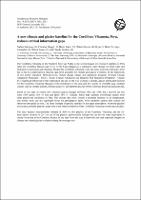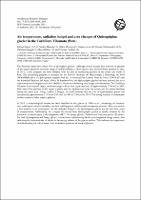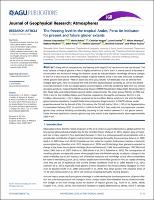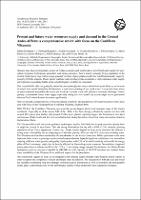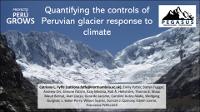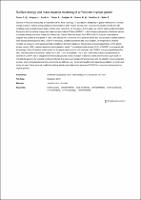Listar por palabra clave "Glacier mass balance"
-
A new climate and glacier baseline for the Cordillera Vilcanota, Peru, reduces critical information gaps
Salzmann, Nadine; Huggel, Christian; Rohrer, Mario; Silverio, Walter; G. Mark, Bryan; Cochachin, Alejo; Suarez, Wilson
(American Geophysical Union, 2013)Acceso abiertoThe Cordillera Vilcanota in the Southern Peruvian Andes is the second largest ice-covered Cordillera in Peru (after the Cordillera Blanca) and serves for the Cusco Region as a temporary water storage for fresh-water and ... -
Air temperature, radiation budget and area changes of Quisoquipina glacier in the Cordillera Vilcanota (Peru)
Suarez, Wilson; Macedo, Nicolás; Montoya, Nilton; Arias, Sandro; Schauwecker, Simone; Huggel, Christian; Rohrer, Mario; Condom, Thomas
(American Geophysical Union, 2015)Acceso abiertoThe Peruvian Andes host about 71% of all tropical glaciers. Although several studies have focused on glaciers of the largest glaciered mountain range (Cordillera Blanca), other regions have received little attention to ... -
Can we use TRMM-PR bright band heights to estimate the snow-rain transition in high mountain regions?
Schauwecker, Simone; Rohrer, Mario; Schwarb, Manfred; Huggel, Christian; Suarez, Wilson; Arias, Sandro; Salzmann, Nadine; Gurgiser, Wolfgang
(American Geophysical Union, 2015)Acceso abiertoField and modelling based research indicates that for tropical glaciers, variations in snow cover and the altitude of the snow line via albedo effects are among the most crucial factors to explain the differences in annual ... -
The freezing level in the tropical Andes, Peru: An indicator for present and future glacier extents
Schauwecker, S.; Rohrer, M.; Huggel, C.; Endries, J. L.; Montoya, N.; Neukom, R.; Perry, B.; Salzmann, N.; Schwarb, M.; Suarez, Wilson
(Wiley-Blackwell, 2017-10)Acceso abiertoAlong with air temperatures, the freezing level height (FLH) has risen over the last decades. The mass balance of tropical glaciers in Peru is highly sensitive to a rise in the FLH, mainly due to a decrease in accumulation ... -
Present and future water resources supply and demand in the Central Andes of Peru: a comprehensive review with focus on the Cordillera Vilcanota
Drenkhan, Fabian; Huggel, Christian; Salzmann, Nadine; Giráldez, Claudia; Suarez, Wilson; Rohrer, Mario; Molina, Edwin; Montoya, Nilton; Miñan, Fiorella
(American Geophysical Union, 2014)Acceso abiertoGlaciers have been an important element of Andean societies and livelihoods as direct freshwater supply for agriculture irrigation, hydropower generation and mining activities. Peru’s mainly remotely living population in ... -
Quantifying the controls of Peruvian glacier response to climate
Fyffe, Catriona L.; Potter, Emily; Fugger, S.; Orr, Andrew; Fatichi, Simone; Medina, Katy; Hellström, Robert Å.; Shaw, Thomas E.; Bernat, Maud; Llacza Rodríguez, Alan; Jácome Vergaray, Gerardo; Aubry-Wake, Caroline; Gurgiser, Wolfgang; Perry, L. Baker; Suarez, Wilson; Quincey, Duncan J.; Loarte, Edwin; Pellicciotti, Francesca
(American Geophysical Union, 2021-04)Acceso abiertoPeruvian glaciers are important contributors to dry season runoff for agriculture and hydropower, but they are at risk of disappearing due to climate warming. Their energy balance and ablation characteristics have previously ... -
Surface energy and mass balance modeling of a Peruvian tropical glacier
Torres, C.; Arigony, J.; Arndt, A.; Tobias, S.; Gurgiser, W.; Suarez, Wilson; Santillan, N.; Maier, É.
(American Geophysical Union, 2019-12)Acceso abiertoGlaciers in Peruvian Andes play an important role for local hydrology. To quantify the availability of glacier meltwater in a climate change scenario, surface energy (SEB) and mass balance (MB) models are required. However, ...







